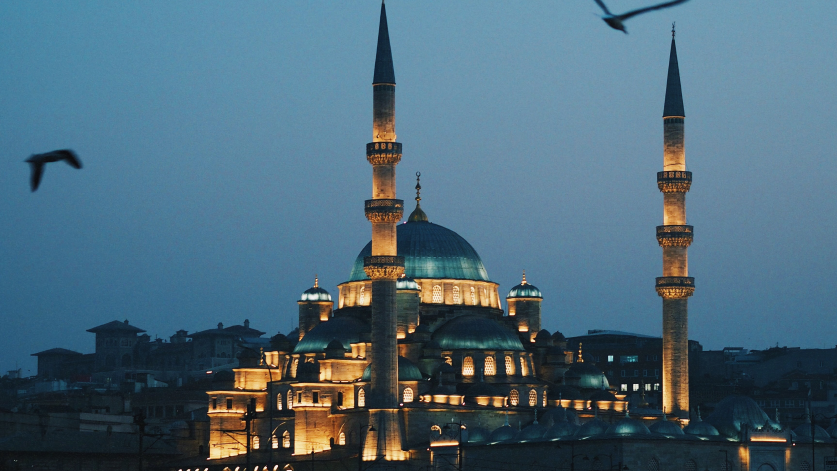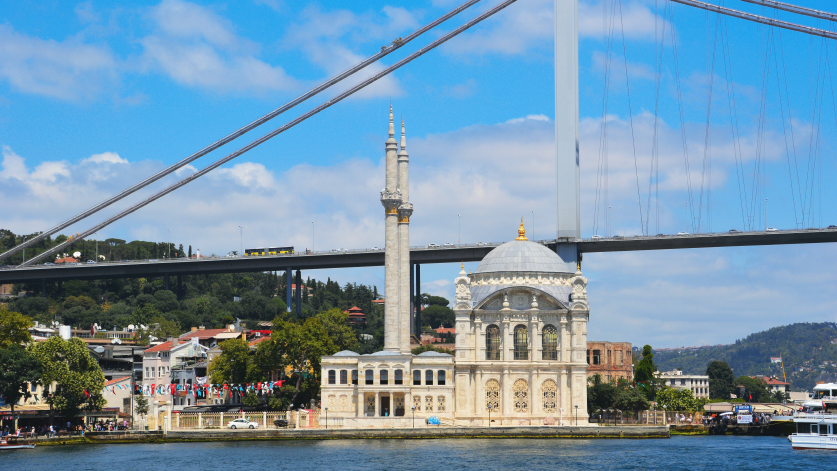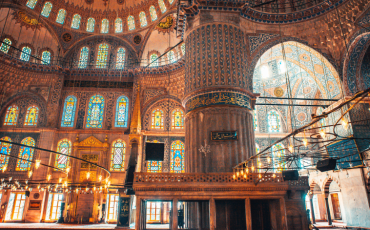What you read in this article:
Istanbul, a city where two continents meet, is renowned for its magnificent skyline adorned with countless domes and minarets. As a city steeped in history, its spiritual landscape is as rich and complex as its past.
For centuries, Istanbul has served as a center of faith, and this is nowhere more apparent than in its impressive number of mosques.
But just how many mosques does this sprawling metropolis hold? The answer is a reflection of its enduring legacy as the capital of the Byzantine and Ottoman Empires and a vibrant modern city today.
The Number of Mosques: A City of Faith
While the exact number can fluctuate with new construction and historical preservation efforts, authoritative sources and official data from the Turkish government indicate that Istanbul is home to over 3,000 mosques.
Some sources even place the number as high as 3,267. This staggering figure includes everything from small, local neighborhood mosques to the grand, imperial complexes that dominate the city’s hills. This immense number underscores the central role of Islam in the daily life and cultural fabric of Istanbul.

A Legacy of Empire and Architecture
The vast majority of Istanbul’s mosques are a product of the Ottoman era, which began with the conquest of Constantinople in 1453. After the conquest, Ottoman sultans and viziers embarked on a grand-scale mosque-building movement, not only as places of worship but also as symbols of their power and piety.
Among these impressive structures is the biggest mosque in Istanbul, a testament to the grandeur of the Ottoman period.
These mosques were often part of larger social complexes, known as külliyes, which included schools (madrasas), hospitals, soup kitchens, and public baths, serving as the heart of urban life.
The golden age of Ottoman architecture was led by the legendary Mimar Sinan, often called the “Michelangelo of the Ottomans.” His genius is evident in many of the city’s most famous mosques, which showcase a harmonious blend of Ottoman and Byzantine architectural styles.
His works, such as the Süleymaniye Mosque, are celebrated for their intricate design, perfect proportions, and innovative engineering that created vast, open interiors.
Iconic and Historical Mosques You Must Visit
While it’s impossible to see all 3,000+ mosques, a few stand out as must-visit landmarks, each with its own unique story:
Hagia Sophia Grand Mosque
Originally built as a cathedral in the 6th century, this architectural marvel was converted into a mosque after the Ottoman conquest, then a museum, and finally reconverted to a mosque in 2020. Its immense dome and stunning mosaics represent a unique blend of Christian and Islamic history.
History and Significance:
The Hagia Sophia’s story is one of transformation. Originally built as the patriarchal cathedral of the Byzantine Empire in the 6th century, it was the largest building in the world and an engineering marvel of its time.
When Constantinople was conquered by the Ottomans in 1453, Sultan Mehmed II immediately converted it into a mosque, preserving its magnificent structure while adding Islamic elements.
It served as a mosque for nearly 500 years before being converted into a museum in 1935 by Atatürk. In 2020, it was reconverted into a mosque, a decision that has a significant impact on its status and use.
Architectural Features:
Hagia Sophia’s most striking feature is its immense central dome, which seems to float above the nave, supported by a revolutionary system of pendentives.
The interior is a breathtaking space, combining the grandeur of Byzantine mosaics (some of which were covered but are now revealed) with magnificent Ottoman calligraphic roundels, representing a unique fusion of Christian and Islamic art. The building also features Ottoman additions like minarets, a mihrab (prayer niche), and a minbar (pulpit).
Blue Mosque (Sultanahmet Mosque)
A true masterpiece of Ottoman architecture, the Blue Mosque is famous for its six minarets and the intricate blue İznik tiles that adorn its interior, giving it its popular name.
History and Significance:
Located directly across from the Hagia Sophia, the Blue Mosque was commissioned by Sultan Ahmed I in the early 17th century. Its construction was a symbol of Ottoman imperial power and a direct challenge to the grandeur of its Byzantine neighbor.
It is one of the most beloved and visually stunning mosques in Istanbul. If you’re wondering how-old-is-the-blue-mosque, its history dates back to the early 1600s.
Architectural Features:
The mosque is famously known for its six minarets, a unique feature that initially caused controversy as it was previously exclusive to the Kaaba in Mecca.
The interior is where the mosque truly earns its nickname: it is decorated with more than 20,000 handmade, vibrant blue ceramic tiles from İznik, featuring intricate floral and geometric patterns.
The light streams in through over 200 stained-glass windows, illuminating the deep blue hues and creating a mesmerizing atmosphere. The grand dome, cascading arches, and vast, open prayer space are typical of classical Ottoman architecture.
Süleymaniye Mosque
A masterpiece by Mimar Sinan, this mosque complex is a symbol of Ottoman power and sophistication. Perched on one of Istanbul’s seven hills, it offers breathtaking panoramic views of the city.
History and Significance:
Often regarded as the finest work of the master architect Mimar Sinan, the Süleymaniye Mosque was built for Sultan Süleyman the Magnificent in the mid-16th century.
The mosque complex, or külliye, was designed to rival the Hagia Sophia and represents the pinnacle of Ottoman architectural and social planning. It is a symbol of the immense wealth and power of the Ottoman Empire during its golden age.
Architectural Features:
The Süleymaniye is a testament to Sinan’s genius. Its dome is a perfect, simplified replica of the Hagia Sophia’s, but it is praised for its structural purity and harmony. The interior is spacious and elegant, with minimal decoration that emphasizes its perfect proportions.
Unlike the Blue Mosque, it is a mosque of light and space. The acoustics inside are so perfect that even a whisper can be heard from across the vast prayer hall. The complex includes a library, a madrasa, a public bath, a kitchen, and a tomb for Sultan Süleyman and his wife, Hürrem Sultan.
Ortaköy Mosque
A stunning example of Neo-Baroque architecture, this mosque sits on the edge of the Bosphorus, providing one of Istanbul’s most picturesque photo opportunities.
History and Significance:
Officially named the Büyük Mecidiye Mosque, this mosque is a much more modern and distinct architectural gem. Built in the mid-19th century by Sultan Abdülmecid I, it represents the shift towards more Western influences in Ottoman architecture during the late empire.
Its location, directly on the shores of the Bosphorus, makes it one of the city’s most iconic and photographed landmarks.
Architectural Features:
The Ortaköy Mosque is a prime example of Neo-Baroque architecture, a stark contrast to the classical Ottoman style. It is characterized by its ornate, highly decorative exterior with a delicate, domed prayer hall.
The minarets are slender and have an intricate, almost lace-like stone carving. The interior is simple but elegant, with a single, large dome and wide windows that offer stunning views of the Bosphorus, creating a sense of openness and tranquility.

Grand Çamlıca Mosque
The largest mosque in the history of the Republic of Turkey, this modern marvel was opened in 2019. It can accommodate a massive number of worshippers and features a blend of Ottoman and Seljuk architectural elements.
History and Significance:
The Grand Çamlıca Mosque is a modern addition to Istanbul’s skyline. Inaugurated in 2019, it was built on Çamlıca Hill on the Asian side of the city.
As the largest mosque in the history of the Republic of Turkey, it was built to accommodate a massive number of worshippers and serve as a modern-day imperial mosque, showcasing contemporary Turkish architectural prowess.
Architectural Features:
The mosque blends classical Ottoman and Seljuk architectural styles with modern engineering. It has six minarets, a massive central dome, and an impressive capacity for over 63,000 people. The interior features contemporary Turkish calligraphy, large chandeliers, and is equipped with state-of-the-art technology.
The design is grand and symmetrical, meant to evoke the classical imperial mosques while offering a modern, expansive spiritual space. The complex also includes a museum, an art gallery, a library, and a conference hall.
Conclusion
The sheer number of mosques in Istanbul is more than just a statistic; it is a profound testament to the city’s spiritual identity. Each mosque, whether a grand imperial complex or a humble neighborhood prayer house, tells a part of Istanbul’s story, a story of conquest, empire, and enduring faith.
They are not merely places of worship but living monuments that shape the skyline, echo with history, and serve as the timeless heart of communities. To count the mosques in Istanbul is to count the threads of its history, and in doing so, to understand its soul.
FAQ
There are over 3,000 mosques in Istanbul, with some sources citing as many as 3,267.
The most famous mosques are Hagia Sophia and the Blue Mosque (Sultanahmet Mosque).
Yes, tourists are welcome to visit mosques. However, visitors must dress modestly and be respectful of prayer times.





Comments